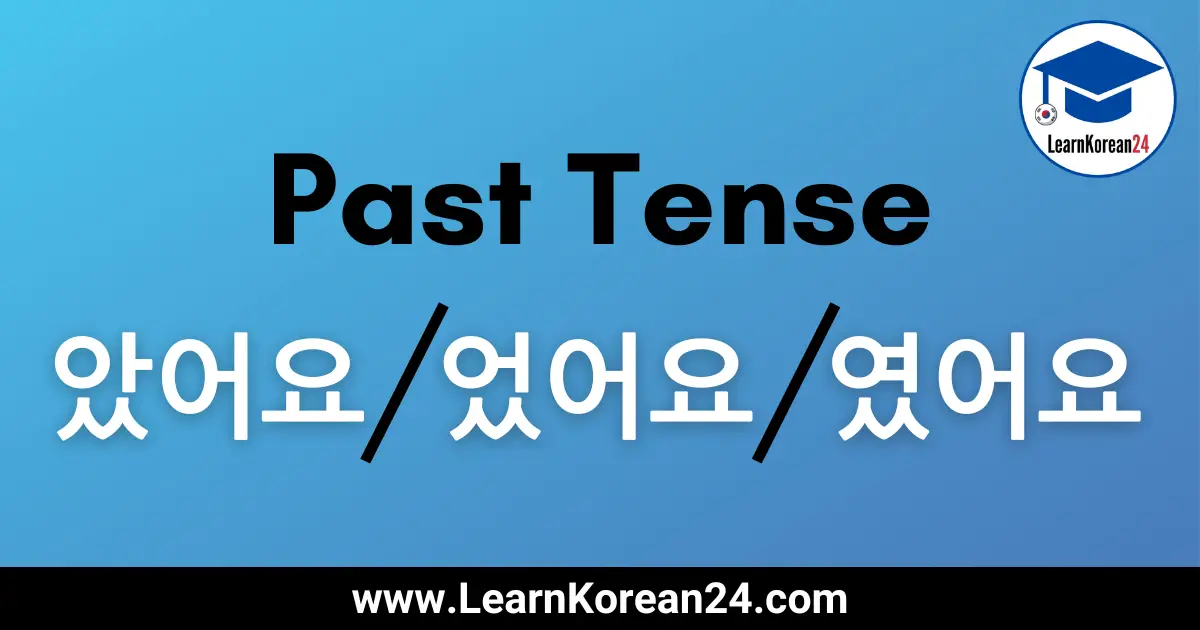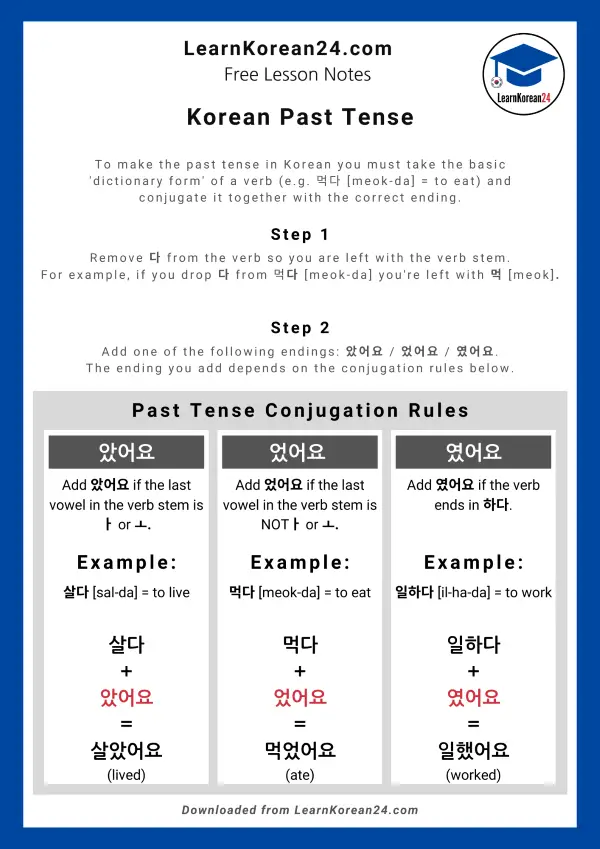Korean Past Tense | Korean Verb Conjugations
In this lesson, you will learn how to make the Korean past tense. By the end of this lesson, you will be able to conjugate Korean verbs into the past tense and to make past tense Korean sentences. In a previous lesson, we looked at how to conjugate verbs in the present tense. If you can remember how to conjugate verbs in the present tense, it is quite easy to conjugate verbs in the past tense.
Related: The Meaning Of Korean Conjugation
Korean Past Tense
To change a Korean verb into the past tense, you must add the correct past tense ending to the verb. The past tense verb endings can be seen in the table below.
| Present Tense Endings | Past Tense Endings |
|---|---|
| ~아요 [~a-yo] | ~았어요 [~ass-seo-yo] |
| ~어요 [~eo-yo] | ~었어요 [~eoss-seo-yo] |
| ~여요 [~yeo-yo] | ~였어요 [~yeoss-seo-yo] |
As you can see from the table above, the past tense verb endings are similar to the present tense verb endings. They also follow similar conjugation rules.
Past Tense Conjugation Rules
To change a verb into the past tense, the first thing you must do is remove 다 from the infinitive form of the verb which will give you the verb stem. Then, you must add the correct past tense ending to the verb to make the past tense.
Past Tense Conjugation Rule 1
If the last vowel in a verb stem is ㅏ or ㅗ, then you add 았어요.
Let’s look at some examples:
| Verb (Infinitive) | Present Tense | Past Tense |
|---|---|---|
| 살다 (to live) | 살아요 | 살았어요 |
| 만나다 (to meet) | 만나요 | 만났어요 |
| 보다 (to see) | 봐요 | 봤어요 |
In each of the examples above, the last vowel in the verb stem is ㅏ or ㅗ. So, to make the present tense we add 아요, and to make the past tense we add 았어요.
Past Tense Conjugation Rule 2
If the last vowel in a verb stem is NOT ㅏ or ㅗ, then you add 었어요.
Let’s look at some examples:
| Verb (Infinitive) | Present Tense | Past Tense |
|---|---|---|
| 먹다 (to eat) | 먹어요 | 먹었어요 |
| 읽다 (to read) | 읽어요 | 읽었어요 |
| 서다 (to stand) | 서요 | 섰어요* |
In each of the examples above, the last vowel in the verb stem is NOTㅏ or ㅗ. So, to make the present tense we add 어요, and to make the past tense we add 었어요.
*Notice that 서다 is 섰어요 in the past tense and not 서었어요. This is because the verb stem already ends in the ㅓ vowel sound.
Past Tense Conjugation Rule 3
If a verb ends in 하다 add 였어요.
Let’s look at some examples:
| Verb (Infinitive) | Present Tense | Past Tense |
|---|---|---|
| 하다 (to do) | 해요 | 했어요 |
| 공부하다 (to study) | 공부해요 | 공부했어요 |
| 청소하다 (to clean) | 청소해요 | 청소했어요 |
This conjugation may look a little strange to you at first as 하다+였어요 becomes 했어요 (and not 하였어요). Originally 하+였어요 was 하였어요 but over time this became 했어요. All you need to remember is that 하다 becomes 했어요 in the past tense.
Korean Past Tense Practice Quiz
Check what you have learned with this fun Korean past tense practice exercise. There are 10 questions. Each question shows you a verb and you must choose the correct Korean past tense conjugation.
Korean Past Tense Sentences
In previous lessons, you learned how to change verbs into the present tense, and how to make Korean sentences. Using what you have learned in this lesson, you should now be able to make simple past tense sentences. Here are some example present tense sentences that have been changed into the past tense.
| English | Korean | Listen |
|---|---|---|
| I buy clothes. (Present Tense) | 저는 옷을 사요. | |
| I bought clothes. (Past Tense) | 저는 옷을 샀어요. | |
| I eat an apple. | 저는 사과를 먹어요. | |
| I ate an apple. | 저는 사과를 먹었어요. | |
| I study Korean. | 저는 한국어를 공부해요. | |
| I studied Korean. | 저는 한국어를 공부했어요. |
Want more Korean verbs to practice making the past tense with? Check our list of 100 Korean verbs for beginners.


